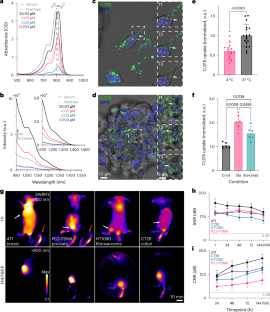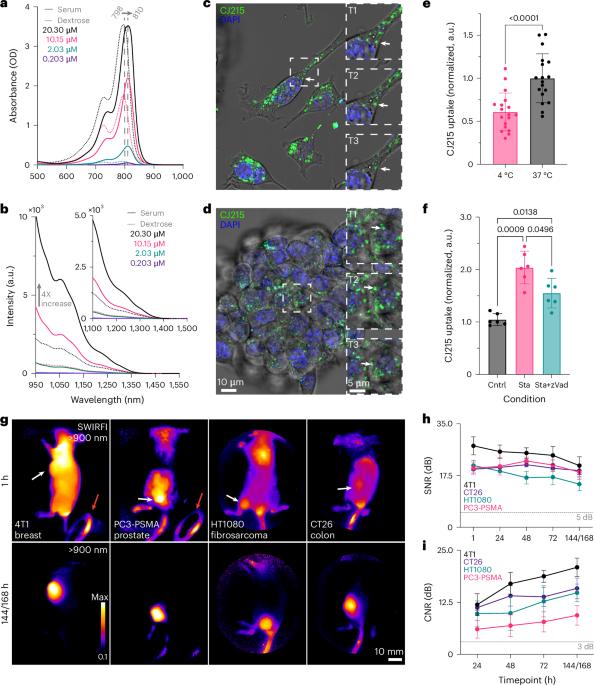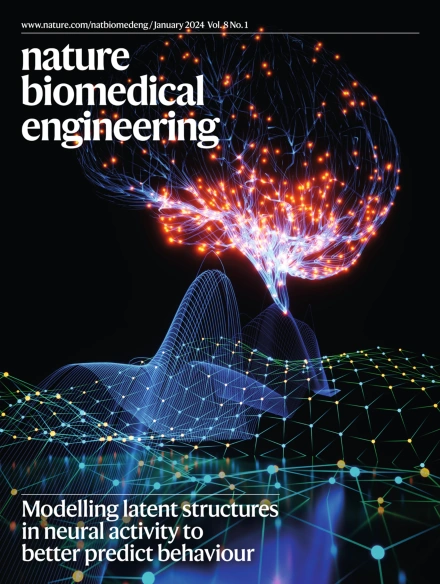A pan-cancer dye for solid-tumour screening, resection and wound monitoring via short-wave and near-infrared fluorescence imaging
IF 26.8
1区 医学
Q1 ENGINEERING, BIOMEDICAL
引用次数: 0
Abstract
The efficacy of fluorescence-guided surgery in facilitating the real-time delineation of tumours depends on the optical contrast of tumour tissue over healthy tissue. Here we show that CJ215—a commercially available, renally cleared carbocyanine dye sensitive to apoptosis, and with an absorption and emission spectra suitable for near-infrared fluorescence imaging (wavelengths of 650–900 nm) and shortwave infrared (SWIR) fluorescence imaging (900–1,700 nm)—can facilitate fluorescence-guided tumour screening, tumour resection and the assessment of wound healing. In tumour models of either murine or human-derived breast, prostate and colon cancers and of fibrosarcoma, and in a model of intraperitoneal carcinomatosis, imaging of CJ215 with ambient light allowed for the delineation of nearly all tumours within 24 h after intravenous injection of the dye, which was minimally taken up by healthy organs. At later timepoints, CJ215 provided tumour-to-muscle contrast ratios up to 100 and tumour-to-liver contrast ratios up to 18. SWIR fluorescence imaging with the dye also allowed for quantifiable non-contact wound monitoring through commercial bandages. CJ215 may be compatible with existing and emerging clinical solutions. A commercial near-infrared dye that is sensitive to apoptosis and that provides high tumour-to-muscle and tumour-to-liver contrast ratios facilitates fluorescence-guided tumour screening, tumour resection and the assessment of wound healing.


通过短波和近红外荧光成像进行实体瘤筛查、切除和伤口监测的泛癌症染料
荧光引导手术在促进肿瘤实时分界方面的功效取决于肿瘤组织与健康组织的光学对比度。在这里,我们展示了 CJ215--一种对细胞凋亡敏感、吸收和发射光谱适合近红外荧光成像(波长为 650-900 纳米)和短波红外荧光成像(900-1700 纳米)的市售肾清除羰花青染料--可以促进荧光引导下的肿瘤筛查、肿瘤切除和伤口愈合评估。在小鼠或人源乳腺癌、前列腺癌、结肠癌和纤维肉瘤的肿瘤模型中,以及在腹膜内癌瘤病模型中,用环境光对 CJ215 进行成像,可在静脉注射染料后 24 小时内勾画出几乎所有肿瘤的轮廓,健康器官对染料的吸收极少。在较晚的时间点,CJ215 的肿瘤与肌肉对比度高达 100,肿瘤与肝脏对比度高达 18。使用该染料进行的西南红外荧光成像还可以通过商用绷带进行可量化的非接触式伤口监测。CJ215 可与现有和新兴的临床解决方案兼容。
本文章由计算机程序翻译,如有差异,请以英文原文为准。
求助全文
约1分钟内获得全文
求助全文
来源期刊

Nature Biomedical Engineering
Medicine-Medicine (miscellaneous)
CiteScore
45.30
自引率
1.10%
发文量
138
期刊介绍:
Nature Biomedical Engineering is an online-only monthly journal that was launched in January 2017. It aims to publish original research, reviews, and commentary focusing on applied biomedicine and health technology. The journal targets a diverse audience, including life scientists who are involved in developing experimental or computational systems and methods to enhance our understanding of human physiology. It also covers biomedical researchers and engineers who are engaged in designing or optimizing therapies, assays, devices, or procedures for diagnosing or treating diseases. Additionally, clinicians, who make use of research outputs to evaluate patient health or administer therapy in various clinical settings and healthcare contexts, are also part of the target audience.
 求助内容:
求助内容: 应助结果提醒方式:
应助结果提醒方式:


